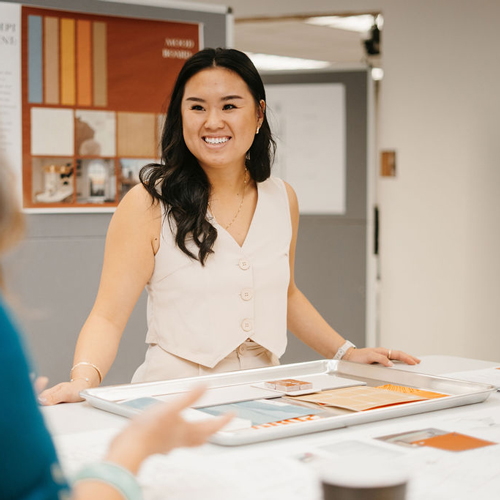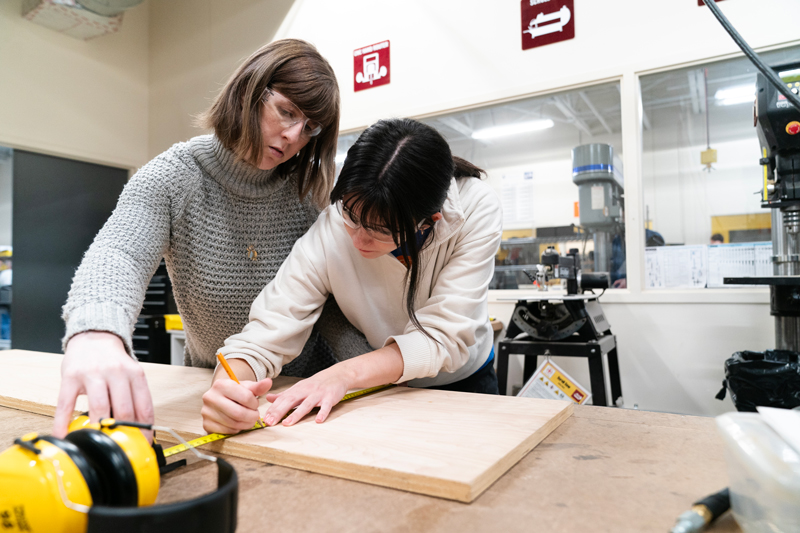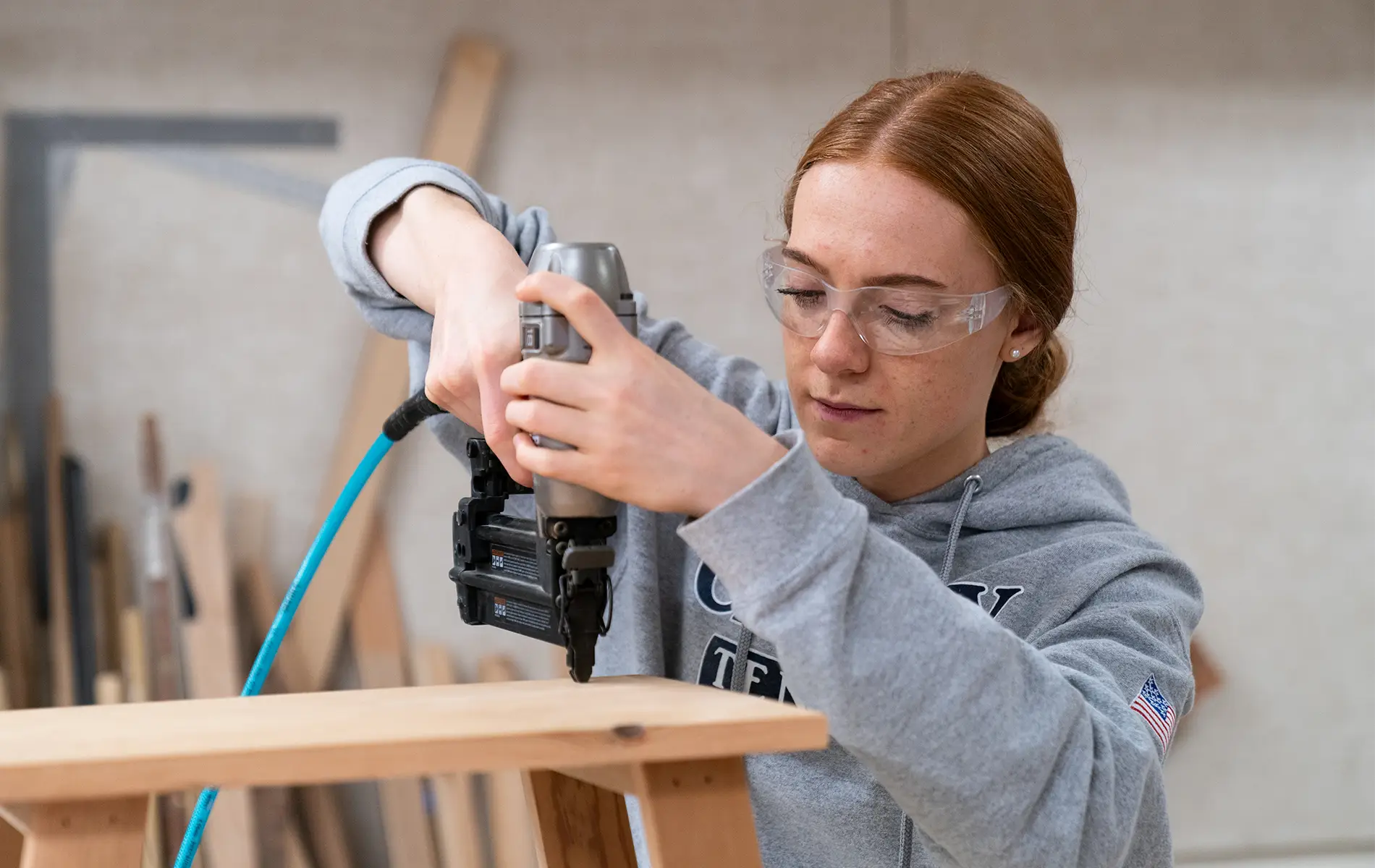At A Glance
Program Type
Bachelor of Fine Arts (BFA)
Accreditation
Northwest Commission on Colleges and Universities (NWCCU)
Experience
100% of interior design students complete a paid internship before they graduate
Outcomes
Program curriculum is based on NCIDQ Certification and LEED accreditation competencies

George Fox's interior design major educates students to become creative and responsible designers of residential and commercial spaces. Program components emphasize problem solving in applied design studios, and with a focus on space planning, sourcing and industry connection, you will learn to design environments for residential and commercial spaces in a broad range of design programs.
Our program focuses on the human health and safety of spaces and prepares students to work in a variety of settings in the professional interior design world. As courses progress, you will be challenged by design problems that increase in size and complexity, and develop an understanding of sustainable building.
Program curriculum and outcomes are all directly tied to NCIDQ (National Council for Interior Design Qualification) Certification and LEED (Leadership in Energy and Environmental Design) accreditation competencies, preparing students to join the interior design industry immediately upon graduation.
Join an Award-Winning Program
George Fox’s interior design program was named the International Interior Design Association’s Campus Center of the Year for 2023 and 2024 – quite an honor considering all U.S. schools with interior design programs were considered!
Professionally Prepared
Our program is deeply connected to the local Portland design industry, and you will work with industry mentors in several classes to create professional relationships. We also work closely with local professional organizations like IIDA and ASID.
Our curriculum is based on the fundamentals of the NCIDQ (National Council for Interior Design Qualification) exam, which you can take after entering the industry. From building codes to ADA regulations, you will be equipped with the knowledge to design for the health, safety and welfare of building occupants.
You’ll also be prepared to take the LEED (Leadership in Energy and Environmental Design) Green Associate exam, allowing you to be a step ahead when you enter the field and be an expert on sustainability before you even graduate.
With a curriculum that covers the facets of both residential and commercial design – by tackling real-world design problems, developing innovative solutions to challenging topics, and learning professional practices for the industry – you'll be equipped to be a successful and creative member of the design community.
The Studio
You’ll gain hands-on experience in classes with real clients. The Studio is a class with a focus on real clients, in which students come alongside real businesses and nonprofits to work on a project being built.
These projects provide you the client-facing experience, budgeting understanding and decision-making skills needed to complete a project. Plus, many projects even pay students for their work.
Recent Studio projects include:
- Forest Grove Foundation Service Hub
- La Salle College Preparatory School
- Kingsley Military Base
Program Distinctives Why Study Interior Design at George Fox?
-
All students complete at least one industry internship, with several students completing multiple internships during their time at George Fox.
-
We are connected to the industry through IIDA, the International Interior Design Association, and student membership fees are covered by the department.
-
The major shares a foundational curriculum with the studio and applied design areas of our program. As a result, students are exposed to an interdisciplinary, integrated curriculum that stresses the broad intellectual development needed for a robust design practice, whether as a team member of a larger design firm or a freelance practitioner.
-
Learn how to be a practicing and professional member of the design community, interacting with industry professionals whenever possible through reviews and industry events.
-
Gain knowledge of universal design when considering your projects, including how building code and ADA requirements fit into space planning and design.
Courses / Curriculum What Will I Study?

Our spaces/Where Will I Learn?
The Lemmons Building
This uniquely-designed building historically has housed the art and design programs. It offers classroom space, a computer lab, and interior design labs.
The Maker Hub
As an interior design student you’ll have the opportunity to create furniture, paint decor, and design projects in our 16,000-square-foot maker hub.
Career Outlook What’s After George Fox
The shape of the interior design field is shifting, creating opportunities for young designers with a vision and technical ability to break into the field and achieve success. In the current booming building industry, interior designers are in high demand and our students graduate with a skill set that allows them to have a front seat in the design industry immediately upon graduation. According to the Bureau of Labor Statistics, employment as an interior designer is expected to grow 3% between 2024 and 2034.
Our students go on to work in a range of design opportunities, from large commercial firms working on offices and hotels to small residential teams designing single family homes. The skill set of our graduates is applicable to a broad range of pathways with an interior design degree, allowing our young designers to choose the design path that’s right for them. They work alongside industry professionals from their first year in the program to allow a broad network to grow throughout their time at George Fox University.
- SERA Architects
- BORA Architects
- LS3P
- DLR Group
- Teal Point Custom Homes
- Tiffany Home Design
- Athey Christian Fellowship
- HBG Memphis
- Design Case
100% of interior design students at George Fox complete a paid internship in their field before they graduate. Here's where some of our student interned during the 2023-24 academic year:
- Mackenzie Inc.
- A&E Design
- Amy Troute Inspired Interior Design
- Hill Devine Design
- Lindye Galloway Interiors
- RJ Smith Construction
- Kelly Frampton Interior Design
- Studio Red Homes
- JAC Interiors
- Studio Garrison
- Tiny Pods for Houseless Population: Working in coordination with the Forest Grove Foundation, students designed trauma-informed interiors for theses spaces
- Alaska Airlines: Students designed an aviation project and engaged with the Alaska Airlines team to understand the company’s standards and branding.
- Kingsley Field BX: Students designed renovations of buildings to bring the Klamath Falls military base to code.

Designing for Houseless Populations
George Fox interior design students partnered with Portland State University students focused on trauma-informed design, color psychology, sustainability and creating a true home for someone who has experience living on the streets for a significant time. The class talked with specialists in trauma-informed design and those who work with the Portland metro’s homeless population. Working in groups of four to five students, the class presented their final design solutions to industry reviewers and members of the community.

Jasmine (Reese) Riihimaki
Our courses have been designed to help us succeed in the world outside of our campus by emphasizing industry standards and practices that might not be in textbooks. Along with connections made with working professionals in my field, the friendships I have made in the classroom are exceptional. In a small major, and at a small school, I have had the opportunity to grow close with my peers. We help each other with projects, offer feedback and collaboration, and create a fun atmosphere to learn and work.
Chat with a current student
Hobbies & Interests: #Coffee, #Hiking #Camping #Running #Traveling, #WorkingOut
About Me: Hello, my name is Michaela! I am a freshman at George Fox and a current interior design major :) Coming from California I am still learning and...Read more
Ask Me About: Adventures in the PNW
“What’s your favorite class?”
“What’s the best student event?”
Request Information About Interior Design
